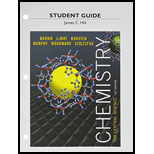
(a)
To determine: The Lewis structure of CS 2 C − S
Solution: The Lewis structure of CS 2
Explanation:
The Lewis structure for a given compound is the representation of bonding and non bonding electron pairs in a molecule. The Lewis structure represents the number of single bonds and double bonds in the molecule along with the lone pair of electrons.
The electronic configuration of C S
C = 1 s 2 2s 2 2p 2 S = 1 s 2 2s 2 2p 6 3s 2 3p 4
Since, carbon atom has two electrons in its p p
The Lewis structure of CS 2

Figure 1
The bond order is defined as the number of bonds between two atoms in a molecule. It is determined by the Lewis structure of the molecules. The number of bonds between carbon and sulphur in its structure are 2. Therefore, the bond order of C − S CS 2 Conclusion:
The Lewis structure of CS 2
To determine: The Lewis structure of
Solution: The Lewis structure of
Explanation:
The Lewis structure for a given compound is the representation of bonding and non bonding electron pairs in a molecule. The Lewis structure represents the number of single bonds and double bonds in the molecule along with the lone pair of electrons.
The electronic configuration of
Since, carbon atom has two electrons in its
The Lewis structure of

Figure 1
The bond order is defined as the number of bonds between two atoms in a molecule. It is determined by the Lewis structure of the molecules. The number of bonds between carbon and sulphur in its structure are 2. Therefore, the bond order of
Conclusion:
The Lewis structure of
(b)
To determine: The structure of
(c)
To determine: The balanced chemical equation for the given reaction.
(d)
To determine: The values of
(e)
To determine: The value of
(f)
To determine: The boiling point of
Want to see the full answer?
Check out a sample textbook solution
Chapter 5 Solutions
Study Guide for Chemistry: The Central Science
 ChemistryChemistryISBN:9781305957404Author:Steven S. Zumdahl, Susan A. Zumdahl, Donald J. DeCostePublisher:Cengage Learning
ChemistryChemistryISBN:9781305957404Author:Steven S. Zumdahl, Susan A. Zumdahl, Donald J. DeCostePublisher:Cengage Learning ChemistryChemistryISBN:9781259911156Author:Raymond Chang Dr., Jason Overby ProfessorPublisher:McGraw-Hill Education
ChemistryChemistryISBN:9781259911156Author:Raymond Chang Dr., Jason Overby ProfessorPublisher:McGraw-Hill Education Principles of Instrumental AnalysisChemistryISBN:9781305577213Author:Douglas A. Skoog, F. James Holler, Stanley R. CrouchPublisher:Cengage Learning
Principles of Instrumental AnalysisChemistryISBN:9781305577213Author:Douglas A. Skoog, F. James Holler, Stanley R. CrouchPublisher:Cengage Learning Organic ChemistryChemistryISBN:9780078021558Author:Janice Gorzynski Smith Dr.Publisher:McGraw-Hill Education
Organic ChemistryChemistryISBN:9780078021558Author:Janice Gorzynski Smith Dr.Publisher:McGraw-Hill Education Chemistry: Principles and ReactionsChemistryISBN:9781305079373Author:William L. Masterton, Cecile N. HurleyPublisher:Cengage Learning
Chemistry: Principles and ReactionsChemistryISBN:9781305079373Author:William L. Masterton, Cecile N. HurleyPublisher:Cengage Learning Elementary Principles of Chemical Processes, Bind...ChemistryISBN:9781118431221Author:Richard M. Felder, Ronald W. Rousseau, Lisa G. BullardPublisher:WILEY
Elementary Principles of Chemical Processes, Bind...ChemistryISBN:9781118431221Author:Richard M. Felder, Ronald W. Rousseau, Lisa G. BullardPublisher:WILEY





